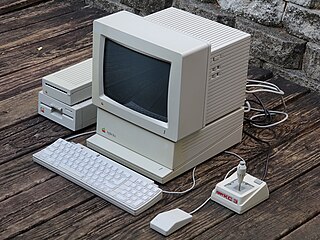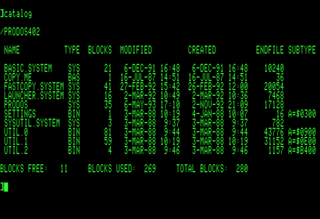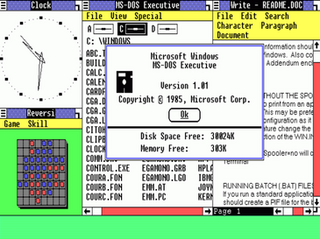Applesoft BASIC is a dialect of Microsoft BASIC, developed by Marc McDonald and Ric Weiland, supplied with Apple II computers. It supersedes Integer BASIC and is the BASIC in ROM in all Apple II series computers after the original Apple II model. It is also referred to as FP BASIC because of the Apple DOS command FP used to invoke it, instead of INT for Integer BASIC.

The Apple II series of microcomputers was initially designed by Steve Wozniak, manufactured by Apple Computer, and launched in 1977 with the Apple II model that gave the series its name. It was followed by the Apple II Plus, Apple IIe, Apple IIc, and Apple IIc Plus, with the 1983 IIe being the most popular. The name is trademarked with square brackets as Apple ][, then, beginning with the IIe, as Apple //. In terms of ease of use, features, and expandability, the Apple II was a major advancement over its predecessor, the Apple I, a limited-production bare circuit board computer for electronics hobbyists.

The Apple III is a business-oriented personal computer produced by Apple Computer and released in 1980. Running the Apple SOS operating system, it was intended as the successor to the Apple II, but was largely considered a failure in the market. It was designed to provide key features business users wanted in a personal computer: a true typewriter-style upper/lowercase keyboard and an 80-column display.

The Apple II is a personal computer released by Apple Inc. in June 1977. It was one of the first successful mass-produced microcomputer products and is widely regarded as one of the most important personal computers of all time due to its role in popularizing home computing and influencing later software development.
Microsoft BASIC is the foundation software product of the Microsoft company and evolved into a line of BASIC interpreters and compiler(s) adapted for many different microcomputers. It first appeared in 1975 as Altair BASIC, which was the first version of BASIC published by Microsoft as well as the first high-level programming language available for the Altair 8800 microcomputer.

The Apple IIGS is a 16-bit personal computer produced by Apple Computer. It is the fifth and most powerful of the Apple II family. It is compatible with earlier Apple II models, but has a Macintosh look and feel, and resolution and color similar to the Amiga and Atari ST. The "GS" in the name stands for "Graphics and Sound", referring to its enhanced multimedia hardware, especially its state-of-the-art audio.

ProDOS is the name of two similar operating systems for the Apple II series of personal computers. The original ProDOS, renamed ProDOS 8 in version 1.2, is the last official operating system usable by all 8-bit Apple II series computers, and was distributed from 1983 to 1993. The other, ProDOS 16, was a stop-gap solution for the 16-bit Apple IIGS that was replaced by GS/OS within two years.
Apple DOS is the disk operating system for the Apple II computers from late 1978 through early 1983. It was superseded by ProDOS in 1983. Apple DOS has three major releases: DOS 3.1, DOS 3.2, and DOS 3.3; each one of these three releases was followed by a second, minor "bug-fix" release, but only in the case of Apple DOS 3.2 did that minor release receive its own version number, Apple DOS 3.2.1. The best-known and most-used version is Apple DOS 3.3 in the 1980 and 1983 releases. Prior to the release of Apple DOS 3.1, Apple users had to rely on audio cassette tapes for data storage and retrieval.

The Sophisticated Operating System, or SOS, is the primary operating system of the Apple III computer. SOS was developed by Apple Computer and released in October 1980.

The Laser 128 is an Apple II clone, released by VTech in 1986 and comparable to the Apple IIe and Apple IIc.
The Apple Pugetsound Program Library Exchange (A.P.P.L.E.) is a users' group established in 1978 by Val Golding.

Call-A.P.P.L.E. is the monthly journal publication of the Apple Pugetsound Program Library Exchange The magazine was published from 1978 until 1990 when it was discontinued; after a 12-year lapse publication was restarted in 2002. The magazine has covered most aspects of Apple personal computers; from the Apple I to the latest Macintosh computers with macOS.

The Disk II Floppy Disk Subsystem, often rendered as Disk ][, is a 5 +1⁄4-inch floppy disk drive designed by Steve Wozniak at the recommendation of Mike Markkula, and manufactured by Apple Computer It went on sale in June 1978 at a retail price of US$495 for pre-order; it was later sold for $595 including the controller card and cable. The Disk II was designed specifically for use with the 1977 Apple II personal computer to replace the slower cassette tape storage.

Computist was a magazine devoted to the Apple II personal computer that was published by Charles R. Haight under the SoftKey Publishing name, between 1981 and 1993, for a total of 89 issues. The magazine was based in Tacoma, Washington. Originally launched as Hardcore Computing, the 'hardcore' part was formally dropped from the title with the 27th issue.

The Apple II Plus is the second model of the Apple II series of personal computers produced by Apple Computer. It was sold from June 1979 to December 1982. Approximately 380,000 II Pluses were sold during its four years in production before being replaced by the Apple IIe in January 1983.
Apple II graphics debuted on the original Apple II in 1977 and were used throughout the computer series of the same name. The graphics consist of a 16 color low-resolution mode and a high-resolution mode where visuals are dependent on artifact color. The Apple IIe added "double" versions of each of these, most prominently "double high-resolution" with twice the horizontal resolution in 16 colors. Internally, Apple II graphics modes are idiosyncratic and do not use a linear frame buffer.

Windows 1.0 was the first major release of Microsoft Windows, a family of graphical operating systems for personal computers developed by Microsoft. It was first released to manufacturing in the United States on November 20, 1985, while the European version was released as Windows 1.02 in May 1986.

Australian Apple Review was an Australian computer magazine published by Gareth Powell Pty Ltd and Saturday Magazine Pty Ltd and initially printed by Offset Alpine and then by Ian Liddel Pty Ltd. The first issue was available in newsagents and dealerships in 1984 at the recommended price of $3.00. Its headquarters was in Randwick, New South Wales.
Comparison of user features of operating systems refers to a comparison of the general user features of major operating systems in a narrative format. It does not encompass a full exhaustive comparison or description of all technical details of all operating systems. It is a comparison of basic roles and the most prominent features. It also includes the most important features of the operating system's origins, historical development, and role.












